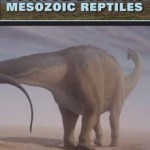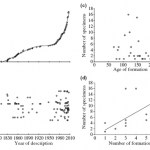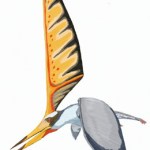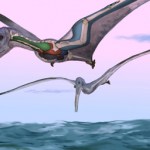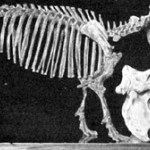pterosaurs
No time to produce anything new, so here's another recycled book review...
While the Mesozoic strata of Patagonia are particularly well known for their diverse and often spectacular dinosaurs, they have also yielded a phenomenally rich record of other Mesozoic reptiles, including turtles, squamates, plesiosaurs, ichthyosaurs, crocodilians and pterosaurs. In this multi-authored volume (another contribution to Indiana University Press's Life of the Past series), Gasparini, Salgado and Coria have edited a collection of 14 papers on the region's Mesozoic reptiles, and on their geological context…
Ok, here we are: welcome to the fifth and final part of that 'month in dinosaurs (and pterosaurs)' series (for previous parts: part I, part II, part III, part IV). This time, more pterosaurs...
In the previous article we looked at the new tiny pterosaur Ningchengopterus (a juvenile Eosipterus?), and at new ideas on nyctosaur crest function. However, another very interesting pterosaur paper appeared in January 2009: Dyke et al.'s (2009) look at morphological disparity in pterosaurs across time. For the record, 'disparity' refers to the degree of morphological variation seen within a clade. It…
Already the article you're reading is several weeks late, and I had to make a real effort to finish it before those weeks became months. Anyway, I present here the penultimate in the 'month in dinosaurs (and pterosaurs)' series (for the previous articles please see part I, part II, and part III). The whole point of this little series was to discuss what happened during January 2009 in dinosaur and pterosaur research. So, we've done the dinosaurs (or, at least, the theropods and ornithischians). This time: pterosaurs. Before launching into the new stuff, I must note that a single, exceptional…
Just when I'm in the middle of talking about the new dinosaurs and pterosaurs that were published in January (part I, part II, part III), February is turning out to be just as interesting. Yesterday saw the debut of the new basal sauropodomorph Panphagia protos (Martinez & Alcober 2009), and you'll know from SV-POW! that Matt Wedel's long-awaited paper on pneumatic hiatuses in sauropods recently appeared in Journal of Experimental Zoology.
Today sees the appearance of another very neat study: Leon Claessens, Pat O'Connor and David Unwin's research on respiration and pneumaticity in…
Yes, it's true. As revealed by my most redoubtable friend and ally Nemo Ramjet, Amerindian people knew of giant flightless azhdarchids long before their possible existence was hypothesised about here at Tet Zoo (follow-ups here and here). Depicting these animals in their artwork, they symbolised them as the great bird Kaloo: this was the most terrifying of all creatures, a stork-headed, long-necked, quadrupedal, flightless bird with long, three-fingered arms and slim legs. Wow.
I am, of course, joking. Nemo discovered an illustrations of Kaloo in a book on mythology and thought that it…
Long-time readers will know that I am an unashamed fan of both speculative zoology, and of Dougal Dixon's hypothetical 'alternative' animals. Inspired by a comment made here in August by Jenny Islander, I have been having a re-think about the possible evolution of flightless pterosaurs: the fossil record gives no indication that such animals ever existed, and maybe they didn't, but that hasn't stopped people from speculating. The best known hypothetical pterosaurs are those from The New Dinosaurs (Dixon 1988), and among the most bizarre and memorable of them is the Lank Herbafagus…
Sorry, another teaser - I haven't yet had time to post the full article (am aiming to do this on Monday). Again, all will be explained as goes the above [incoporating artwork by Mark Witton and yours truly]. Many, many, many thanks to everyone who made the 'name my flightless pterosaur' experiment such a soaraway (ha ha) success - I really enjoyed seeing your suggested names, many of which were excellent and/or very amusing. And the winner is...
Well, in the end I combined two different suggestions: the binomial is Shemhazai ptychocheirus. I don't expect you to agree with this choice, but I…
Don't worry, all will be explained in the next article. But first things first: please provide the flightless azhdarchid with a binomial name. The cleverest and most euphonious wins (and I pick the winner). Please explain derivations and etymologies where appropriate. Good luck.
For my shame, I had never been to Ireland prior to last week. That's so crap that I became pretty determined to attend the 56th SVPCA, hosted by the National Museum of Ireland at Dublin, and I'm glad I did. You know, because of the giant deer, hornbills and pliosaurs [montage here shows specimens from the (currently closed) National Museum of Ireland (Natural History). The middle skeleton is a Notoryctes]...
Here I'm going to do a very speedy review of most (but far from all) of the presentations given at the meeting. There was a reasonable amount of non-tetrapod stuff that I won't, of…
Only time right now for one of those brief Dave Hone-inspired Tet Zoo picture of the day posts (or TZPOTDPs, yeah), and what with all the azhdarchoid news lately (Lü et al. 2008, Witton & Naish 2008) it's only fitting that we have more pterosaurs. Here's a photo I took back in the days of Tet Zoo ver 1 (June 2006): it shows what we might call The Birthplace of Pterosaurs, or God's Workshop or, more prosaically, downstairs at the School of Earth and Environmental Sciences, University of Portsmouth...
You'll note the tupuxuarid model that you might previously have seen in its blue phase,…
Observant readers might have noticed the several recent references to 'big news in a big journal' coming soon, or on 'how a Tet Zoo article evolved into a peer-reviewed technical publication'. Yes, not all of Tet Zoo is idle nonsense written for fun; at least some of it results in actual peer-reviewed result: you know, the stuff that's made me the fulfilled, famous, financially successful person I am today. And long-time readers might recall the threat, from way way back in April 2006, that 'Why azhdarchids were giant storks' represented '... the better part of a paper on the subject [of…
So, was it really 'the best conference of all time'? Hmm, maybe, but it was excellent and all went well (more or less). On May 6th and 7th I attended 'Dinosaurs (and other extinct saurians) - A Historical Perspective', a meeting featuring a packed schedule of talks and posters devoted to Mesozoic fossil reptiles and how they've been discovered and interpreted. Ably abetted by John Conway yet again, I made it to London on time for the field trip on the 5th to the Crystal Palace animals, and on the 8th and 9th went on a trip to the Isle of Wight (going both into the field and to Dinosaur Isle…
It was Beelzebufo that finally made up my mind. Long-time readers will have noticed that I generally fail to discuss the exciting stuff that's being announced in the news, even when it's very much relevant to the Tet Zoo remit. Indeed some of you have even commented upon this fact. What's my excuse for this? Well there are a few actually...
-- For starters, once I've decided to blog about something - say, initial bipedalism or European pumas or liolaemine lizards - I need to stick with it and get it out of the way. Because I have a long list of subjects that I plan to blog about, I am not…
Those of you with particularly good memories might recall the little references I've been making here and there to a 'big, personally-relevant publication', and those asides to new papers about pleurodires and enantiornithines. Following horrific delays (caused by amphibians, dinosaur growth rates, ichthyosaurs and conferences) I am, finally, pleased to announce that Cambridge University Press' huge new book, The Crato Fossil Beds of Brazil: Window into an Ancient World (Martill et al. 2007), was published in December 2007 and is now available. If you're interested in Cretaceous anurans,…
Or - alternative title to this article - 'It will be the best conference of all time' (no hyperbole at all). Do you like dinosaurs? Are you particularly interested in our changing ideas about dinosaurs, about key discoveries and concepts, or about the evolution of our ideas, reconstructions and theories about dinosaurs? If the answer is yes then get ready to come to London in May 2008 for Dinosaurs - A Historical Perspective...
On May 6th and 7th this year, Burlington House in Piccadilly (London) will be hosting this most prestigious of meetings. We've arranged it through the History of…
As a dinosaur specialist I often get asked about Robert Mash's 2003 book How to Keep Dinosaurs (Mash 2003). It seems that most people (usually those who haven't read it) think that this book is good, or funny. Don't get me wrong - I think a book dedicated to dinosaur husbandry is an excellent idea; the problem is that Mash didn't do it well.
I should explain to begin with that How to Keep Dinosaurs is set on a parallel Earth where Mesozoic non-avian dinosaurs, pterosaurs and other ancient reptiles live alongside humans. A while back I reviewed How to Keep Dinosaurs for Fortean Times and,…
One last thing before Tet Zoo closes down for Christmas but, don't worry, this isn't anything I've knocked up specially... due to an unfortunate series of misunderstandings it's something I produced 'by mistake' and have since decided to recycle. Hey, why not. Ironically, I post it just when I'm in the middle of two other pterosaury bits of work (more on those soon). So I never did get to finish the anuran series before Christmas, nor post about that big, personally-relevant publication which has just appeared, nor get through the titan-hawks, monster pigeons and whatnot. And what about all…
How did the centenary workshop on mammal bone identification go, I hear you cry? It went very well, thank you very much. Anyway, as promised here are more of various recollections from the 55th SVPCA, held at the University of Glasgow between August 29th and September 1st. For previous of my thoughts visit part I here, and for abstracts, photo galleries and more, visit the SVPCA site here. In this article, I'm going to review the dinosaur talks. You have been warned.
[I should explain the photo montage used here. For reasons that might have been mysterious to him, Bob Nicholls (of…
If I hadn't spent so much time yesterday socialising and celebrating Will's 6th birthday, then this post - the third part in my series on the events of the Wellnhofer pterosaur meeting (part I here, part II here) - might have been finished earlier. Oh well, priorities and all that. Before I start: I assume everyone who visits Tet Zoo knows that scienceblogs is holding a 500,000th comments contest: whoever posts the 500,000th comment will win a 5-day trip to the 'greatest science city in the world' (and there is a vote as to exactly which city that might be). So, anyway, as if you didn't have…
On to more of my thoughts about the outstanding Wellnhofer pterosaur meeting, held at the Bayerische Staatssammlung für Paläontologie und Geologie (Bavarian State Palaeontological Collection - BSPG) in Munich last week. For part I go here, and for initial thoughts on what a neat conference it was go here. For those of you wondering (and for those of you that know that the pterosaur meeting was the third of three conferences I attended during August and September 2007), my plan is to talk about all three conferences, but in reverse order. Once I finish talking about pterosaurs, I'll do SVPCA…
